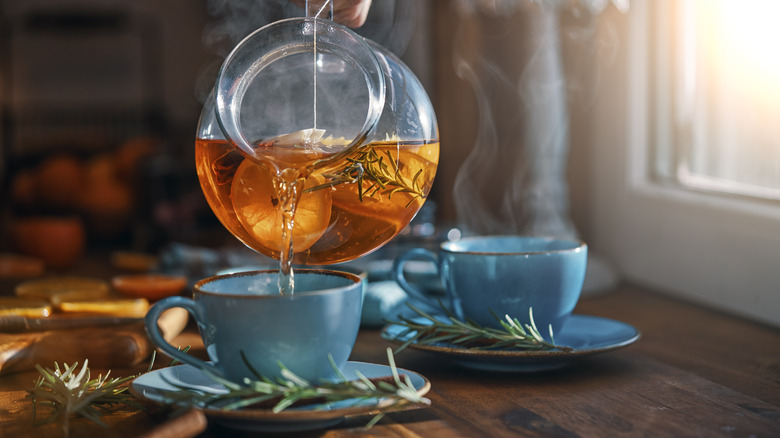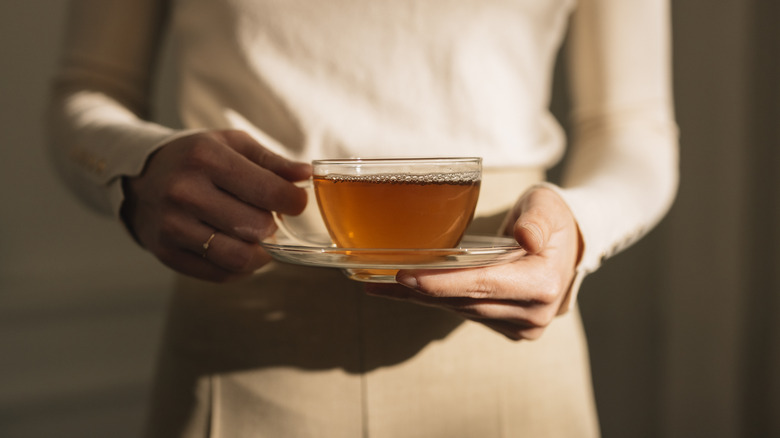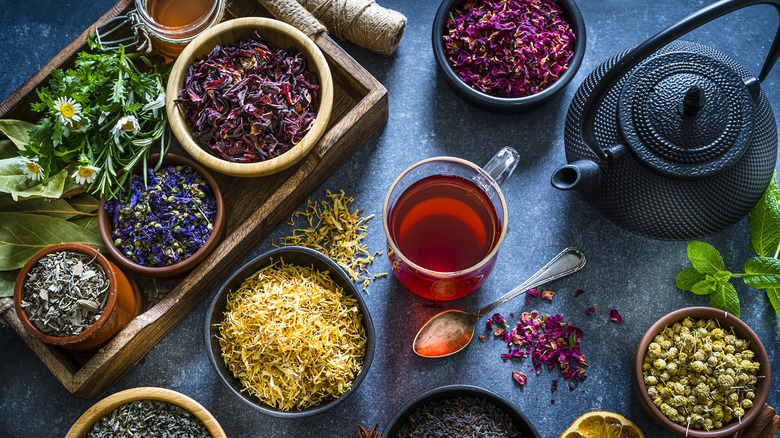The Simple Ingredient Adjustment For More Delicious Tea
All it takes to make a cup of hot tea come to life is some hot water and a few fresh tea leaves. Still, some people really know how to make this simple indulgence sing — and they don't need any new ingredient to make it happen. They just up the quality of what's already there.
While quality tea leaves are an essential part of a great cup of tea, that's not the ingredient we're concerned about. The type of water you use in your cup matters just as much. When it comes to brewing hot tea, you should be using fresh water every time. While it's tempting to use some of the leftover liquid that's been waiting around in your tea kettle, fresh and '"old" water are far from the same. Leftover boiled water won't make as satisfying a cup as fresh will, and there's a scientific reason behind why.
Why you need to start with fresh water every time
Using the water that's been sitting in your kettle for fresh tea will make your cup taste dull and flat. This water has a much harder time extracting the flavor from your tea leaves compared to fresh because water that's already been heated becomes deoxygenated. High temperatures can strip water of its natural air bubbles. Tea leaves need oxygen to properly release their flavor, so for the best cup, use cold, filtered, and freshly drawn water every time.
When heating up your fresh water for a perfect hot cup of tea, also try using a thermometer. This way you can get your water to the ideal temperature without overheating, which leads to further loss of oxygen in your water with no benefits. Different teas require varied water temperatures, so do your research for an exact measurement. Typically black teas will steep best in water that's about 212 degrees Fahrenheit, while green tea tastes better around 175 degrees Fahrenheit. Once you heat your fresh water to your ideal temperature, you can then immediately pour it over your leaves and enjoy.
Pre-boiled water might taste flat, but there is no harm in drinking it, so it's still okay to use if you're in a rush. If quality is your priority though, you might want to think twice. And for those worried about wasting that leftover water, simply start measuring out how much water you need before filling up your kettle.
Other ways to ensure a well-rounded cup of tea
While the freshness level of your water is important, so is the temperature. Contrary to popular belief, you should not always be using boiling water for your hot tea. Boiling water can burn tea leaves and leave your cup with a bitter taste. That's just another reason to use a thermometer — tea leaves are fragile, so heating water to exactly the right temperature is key. This way your tea leaves will steep and blossom perfectly without becoming scorched.
The type of tea you use in your cup is just as important, so try to get the highest quality leaves you can. Tea leaves are typically a better choice than bags, which often don't use quality tea. Do your research to discover which leaves are right for you and smell them beforehand to make sure they're fresh. A vibrant color is also a promising sign of quality tea. Once the base elements of your tea are of the highest quality, you can make your cup taste even better from there. Just like a sprig of rosemary can really elevate a gin fizz, a beautiful tea cup and kettle set can really elevate your experience, helping to invigorate your sense of taste, smell, and now sight.
While making hot tea is easy, there's a lot you can do to make it perfect with minimal extra effort. Give some of these tips a try and enjoy a potentially life-changing cup of hot tea.


